At the Junction of Art and Activism—A Conversation with Patrisse Cullors
| August 6, 2020
Artist, educator, writer, activist and organizer Patrisse Cullors grew up in Los Angeles, witnessing her father, brother and countless people of color being incarcerated, brutalized, and dehumanized. Motivated by her will for social change, Cullors often employs bodily movement in conjunction with text as her primary media of her artistic practice to confront urgent socio-political issues, blur the dichotomy between art and activism, as well as create narratives of resilience, healing, solidarity and freedom. For two decades, Cullors has stood on the frontlines fighting against racial inequality and the broken system of criminal justice. She is one of the three fearless cofounders of Black Lives Matter that has helped shifting the current political discourses of race, gender, and class on a massive scale. Our contributor Danielle Shang recently sat down with Cullors in Los Angeles to talk about the history of Black Lives Matter, the prejudice against the movement, the deep trauma wound represented by 45’s regime, and how these issues are embedded in Cullors’s artistic and pedagogic practices.
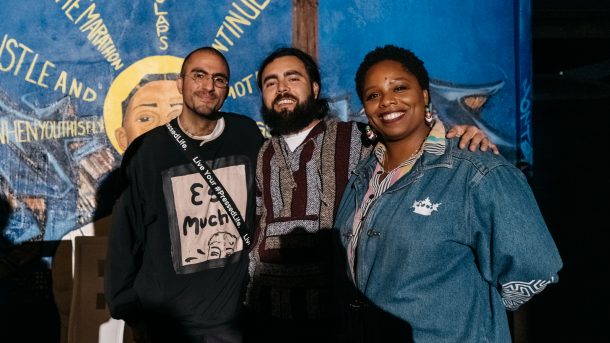
Danielle Shang (DS): The senseless murder of George Floyd by Minneapolis police on May 25, 2020, has set off waves of intense protests, characterized as Black Lives Matter Movement. We see the unequivocal shift of public opinions on police brutality and systematic racism. Could you crystallize the origin of Black Lives Matter and highlight a couple specific demands from the current movement?
Patrisse Cullors (PC): Black Lives Matter was first started as a phrase by Alicia Garza in response to the killing of Trayvon Martin in 2012, and later I created the hashtag, before Alicia, Opal Tometi and I eventually co-founded in 2013 the organization bearing the same name with affiliated chapters across the country and the globe. Now it has become the phrase shared by the organization and the grassroots movement for the past two months.
The primary demand since May 25 has been to defund the police: demilitarizing the police and reallocating necessary resources to support mental health services, adequate education, access to jobs, etc., especially in underserved communities of black and brown people for them to not only survive but also to thrive.
In the wake of the killings of Ahmaud Arbery, Breonna Taylor, George Floyd, and countless unarmed innocent black people, cities across the country have taken the action on a local level to reduce the police force and police budgets. For instance, the Minneapolis city council announced the plan to dismantle the police department and create a new model of public safety and violence prevention based on community input. No-Knock Warrants are now banned in Louisville, Kentucky. The new legislation was named after Breonna Taylor who was murdered in her sleep at home during a police raid at the wrong address.
The San Francisco school board voted unanimously to remove police from the public school campus.
DS: Many have superficially mistaken defunding the police for withdrawing funding for police and abolishing law enforcement entirely. As an ardent prison abolitionist, what is your vision of defunding the police?
PC: To defund the police is not equivalent to no accountability or to disregard public safety. It advocates for a different model of service and protection other than policing and punishment.
Two formidable historic features of American society—the institution of slavery and the control of minorities—shaped early policing. Slave patrols, which were originally deputized to capture slaves who were seeking emancipation, later became modern police departments. [1]
In Los Angeles, the police is the first response to the case of mental illness, which often escalates the situation. If we have doctors respond to heart disease or cancer, then why cannot we have health services and social workers to assist mental patients? It is time to re-negotiate public safety and accountability.
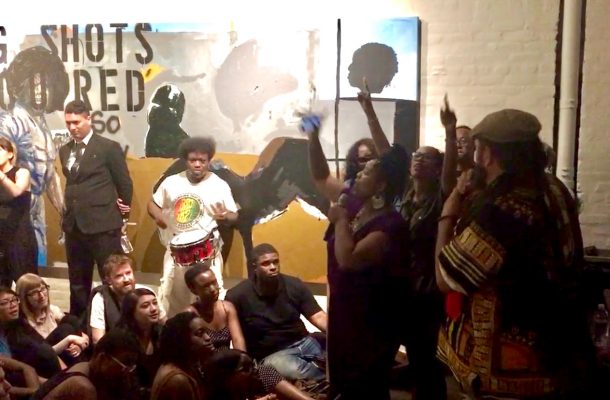
DS: Unlike previous civil rights movements, Black Lives Matter was initiated and led by three strong black and queer women. How does this feminist leadership impact the movement and LGBTQ community?
PC: It reflects our deep desire for a new form of leadership. Black women, historically, have been architects and on the frontlines of movements for social change. We are following the footsteps of Ella Baker, Coretta Scott King, Angela Davis, and Diane Nash.
In addition, we are the first movement to address discrimination against and lack of access for black trans women. In June, LGBTQ rights activists honored Pride Month, protesting alongside the Black Lives Matter Movement. We jointly organized solidarity marches in numerous cities on June 14. The next day, the Supreme Court passed a landmark civil rights law that protects gay and transgender workers from workplace discrimination. However, we must continue to uplift that conversation, because we see a horrific spike in fatal violence against trans women in the US this year. The most marginalized people in that community are black trans women.
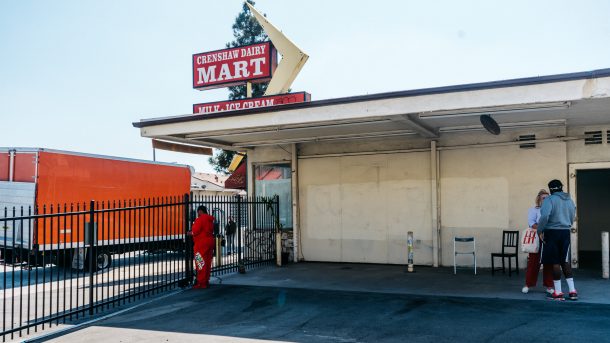
DS: Aside from Black Lives Matter, you have also founded Dignity & Power Now and Crenshaw Dairy Mart. What are the goals for each organization?
PC: Dignity & Power Now is our community’s response to the violence against incarcerated people in the county jail. Multiple organizations and coalitions were developed under the umbrella, including Coalition To End Sheriff Violence that proposed the ballot Measure R, which was passed by voters this year. Measure R authorizes the Sheriff Civilian Oversight Commission—the first independent commission of the police department—to develop a plan for reducing incarceration, and grants the Commission subpoena power to investigate complaints. We also created Justice LA to fight the Los Angeles County jail expansion, resulting in stopping the county from building two new jails last year.
Crenshaw Dairy Mart, founded by Alexandre Dorriz, Noé Olivas, and me, came out of the need to develop programs that support artists at the intersection of politics, community organizing and art. It is a space investing in conversations about our ancestry, prison abolition, accessibility in art practice, and solidarity.
We see ourselves as abolitionist artists and social practitioners whose work continues the long legacy of artists who champion radical politics. After spending the first two years creating a space to reach out to and connect with the community in Inglewood, we launched our first exhibition Yes On R, revisiting Dignity and Power Now’s archives and conceptions from 2011 to 2013.
When COVID-19 hit California, artist Lauren Halsey posted on Instagram to fundraise for donating fresh produce every two weeks to black neighborhoods in South Central. My team at Crenshaw Dairy Mart reached out to Lauren to collaborate with Summaeverythang, her nonprofit community center founded on the principle of empowerment through self-directed action. Summaeverythang now delivers organic produce from Southern California farms together with art supply kits and lesson plans prepared by our team bi-weekly.
DS: I love the idea of democratizing culture and giving a voice to society’s disenfranchised in your community art and social practice. Your autobiographically informed practice not only illustrates political trenches, but also puts you directly in the trenches. It is impossible to separate you, the artist, from you, the activist. Theorist Claire Bishop complains that community art “has no secondary audience: it has no discursive framing nor an elaborated culture of reception to facilitate comparison and analysis with similar projects, because community art is not produced with such a critical audience in mind.” [2] How do you respond to that?
PC: I am aware of the existence of such critique. It’s such a boring analysis and a flattened, apolitical and dangerous interpretation of what community art or social practice is doing. It’s narrowly shaped around the rhetoric of the conservative art canon. I was trained by social practice artists who came out of the 1960s, such as Suzanne Lacy whose art is deeply critical, political, but engaging. Community art calls for a different type of consideration of art and artist in a much bigger sociological context. Art historian Jonah Westerman once remarked, “Performance is … … a set of questions and concerns about how art relates to people and the wider social world.” [3] I think performance artists have a unique platform to propose art’s re-imagined social role and critical capabilities.
DS: You first earned your degree in religion and philosophy from UCLA. What made you want to pursue a master degree in fine arts? Why do you focus on non-object-based performance as your practice?
PC: I was an artist, a trained dancer, before I was politicized. As I grew older, I became aware of the politics and exploitation in the dance world, which made me feel disconnected to dance but more to expression and movement. My first performance was in 2012, titled Stained: An Intimate Portrayal of State Violence, in response to American Civil Liberties Union’s 86-page complaint about Los Angeles County sheriff’s deputy-on-inmate violence and cover-ups. It marked an important departure for me. I performed that piece throughout Los Angeles County for six months. During that time, Dignity and Power Now was born.
DS: Your performance has a strong overtone of communion and anti-commercialism. Performing in public constitutes a space of both self-presentation and shared presence with the audience. What do you do to engage your audiences, evoke their awareness of social conditions, and thereby to hopefully impel them to take action?
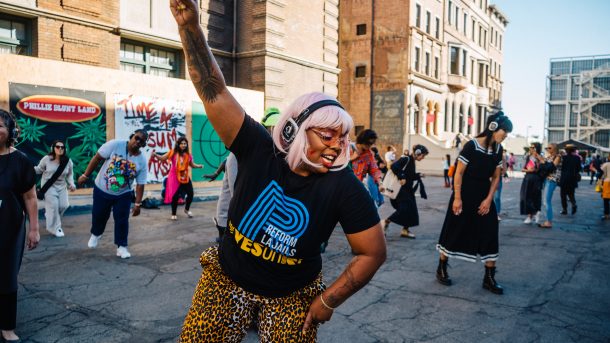
PC: 45’s regime is profoundly demoralizing. (45 is a pejorative nickname for Donald Trump, who is the 45th president of the US.) He represents the deep trauma wound that this country hasn’t healed from. When migrant children were first rounded up and caged at the US-Mexico border, it incited so much rage, despair, and pain that nearly drove me into self-sabotage and self-isolation, but I refused to allow 45 to overpower me. As a result, I created Fuck White Supremacy, Let’s Get Free (2019), a joyful, disco-style group dance of the Electric Slide. I want to ally the community together and to channel the agency of healing through art. The first time I organized the public dance was at the parking lot of LTD gallery. 200 people showed up to dance for two hours; it was powerful and beautiful. I then reenacted the performance as a silent disco with headphones at Frieze LA this year. It was an epic call for action: an action for accessing our joy at the highest state of trauma.
Although I choreograph my movements, collaboration with other artists is essential to my practice. The camaraderie definitely helps broaden the engagement with social reality, the specificity of space, and identity politics.
Much of my art has come from a place of trauma and pain, both personally and collectively. But artist Noé Olivas’s practice is rooted in healing. So I asked him to collaborate to rejuvenate my spirit for a performance in response to Zoe Leonard’s I Want A President (1992) at Hauser & Wirth Gallery, Los Angeles, in 2018.
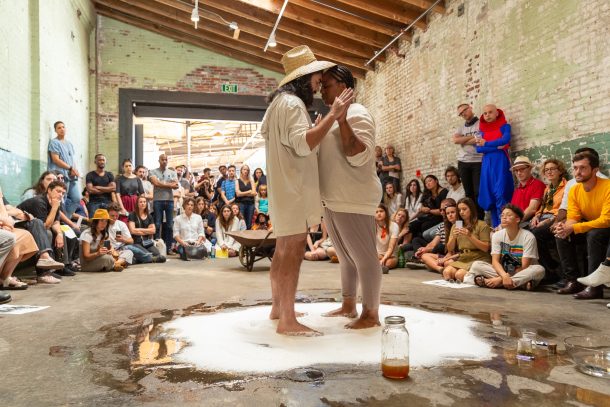
DS: In this performance, the motifs of honey, milk, and salt appeared again. How do they help your articulation of black body, trauma, healing and unity?
PC: Honey is a metaphor for the sweetness that we could bring to the world. Coconut milk is a replenisher. Milk and honey is the biblical reference to the Promised Land. Salt symbolizes preservation. Water is a cleanser and unifier. Nigerian Afrobeat musician and human rights activist Fela Kuti once sang, “Water has no enemy.” Those motifs are critical elements in my MFA thesis, titled Respite, Reprieve, and Healing: An Evening of Cleansing (2019), which was the most vigorous piece that I have done: putting my body in 400 pounds of salt, then excavating myself, crawling towards a bath tub filled with coconut milk, and bathing in it. It was a journal of resurrection and renewal.

DS: You recently became the faculty director for the MFA program of Social & Environmental Arts Practice at Prescott College. What is the syllabus like?
PC: It’s a 2-year online MFA course. We are working with artists who are already at the intersection of art and politics, and making social practice art for quite sometime. The five faculty members, who all graduated with me from the same MFA class at USC, created courses for this program. I teach introduction to Social & Environmental Arts Practice that surveys theories of Social & Environmental Arts Practice, as well as Social Practice course that investigates how social practice art addresses political, social and environmental issues, and studies how artists, such as Suzanne Lacy, Theaster Gates, and Emory Douglas, represent different ideas. We read works by theorists such as bell hooks.
Jake Freilich teaches our history course through the lens of decolonization, scrutinizing the act of pillage and its ramifications. Many questions have emerged from the scrutiny. Are we supposed to be content with such a problematic art history as artists? What does it mean for the current art world?
Noé Olivas teaches the course on art of healing addressing how to channel healing modality into the art practice.
DS: I want to unpack Stuart Hall’s theory of articulation with you. How do you connect the personal with the political in your artistic, political, pedagogic practices? In other words, how do you choose the right vocabulary to translate the discourse for different audiences?
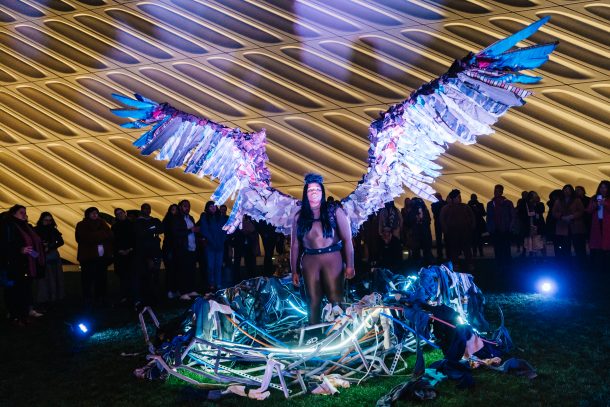
PC: I often ask my students, “What social ills are you motivated by for social change? How can your art be service to that?” I want them to think creatively about art in relation to society. The socio-political issues addressed by artists don’t have to be worn on the nose. It can be embedded in forms of incredibly high aesthetics. Artists must take advantage of the medium, be it painting or performance or photography, to create another conversation.
In February 2020, I performed a piece, titled Prayer To Iyami, at the Broad Museum. Iyami is altered from the West African Yoruba word of “my mother.” Wearing a pair of 20-pound robotic wings built with the old clothing of my brother Monte who was brutalized and stripped of dignity in jail, while suffering a serious mental condition. I gathered more of his clothes from a tree to adorn a nest on the ground illuminated by lights. The audio for the performance includes a score by the writer James Baldwin speaking about white supremacy and systemic racial injustice. I read to the audience the proposal of the ballot measure R, the jail reform act.
DS: This country has been dehumanizing black people for too long. The process of repairing has yet to begin. But where should we begin? What are your thoughts on Truth & Reconciliation Commission in South Africa?
PC: Truth & Reconciliation cannot happen without reparation. Merely exchanging words with the people who have harmed us for quite some time is not enough. We need to repair the damage and recover from the sickness. Reparation means to reallocate resources to invest in the black community, which could be the beginning of Truth & Reconciliation.
I encourage folks to pay attention to HR40 introduced to the House last year. This bill establishes the commission to study and develop reparation proposals for African-Americans. The commission also examines slavery and discrimination in the colonies and the United States from 1619 to the present, recommends appropriate remedies, identifies the role of federal and state governments in supporting the institution of slavery and the resulted lingering negative effects on society.
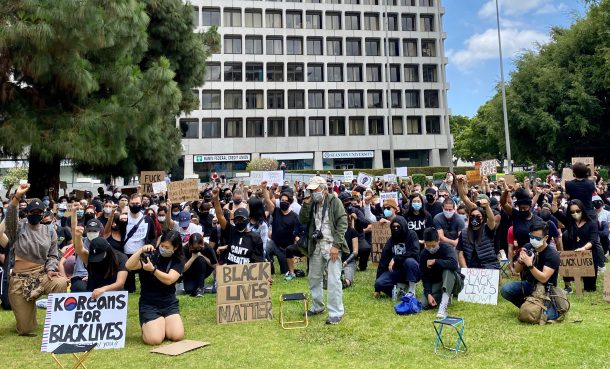
DS: Many people, both in the US and in Asia, decry the current Black Lives Matter movement; some even applaud police for enforcing law and order. They criticize black people for presuming a sense of entitlement or turning a blind eye to their own violence and crimes or disregarding lives of non-black people. Some dismiss the movement as a nonsensical posture of political correctness. If you have an opportunity, what would you say to them?
PC: This kind of thinking is racist and politically lazy. This movement is not about persecuting white people or Asians, but urging a broader vision of justice and equality for all.
If you don’t have deep connections to our black community and our movement, then you are basing your opinions on stereotypes and years of discrimination. Now is the perfect time to learn the brutal and violent history of this country that has relegated black people to the margins at best, or subjected us to deadly abuses at worst.
Practice of learning and listening will help our allies understand the rage and the pain that the black community has gone through. We invite everyone to join us for the fight and follow the leadership to change the outcome of that history. We can promise that when our lives get better, everyone else’s life will get better too, because we are in this together.
DS: On a global scale, what urgent issues do you see that are intersected with state sponsored violence against marginalized people (people of color, LGBTQ, immigrant workers, mentally ill people, homeless) in the US?
PC: The US has played a terrible role in decivilization in the world. 45 has demonized Chinese and Chinese Americans. Our relationship to the Arab world is horrific, as well as to Latin America. The current border crisis further devastates Latin American immigrants who left the countries that the US has destabilized. A part of our work as organizers and activists is to understand that global role played by the US and fight against it, so that we can discontinue exporting violence and harm across the globe.
The late civil rights giant and congressman John Lewis once argued, “We must continue to go forward as one people, as brothers and sisters… to find a way to get in trouble, good trouble, necessary trouble.”
- [1] Professor Khalil Gibran Muhammad and Professor Victor E. Kappeler have written and published extensively on the history of slavery and the origins of American policing.
- [2] Claire Bishop, Artificial Hells: Participatory Art and the Politics of Spectatorship, 2012, Verso: London & New York, 190.
- [3] Jonah Westerman, “The Dimensions of Performance,” Performance at Tate: Into the Space of Art, Tate Research Publication, 2016, https://www.tate.org.uk/research/publications/performance-at-tate/dimensions-of-performance, accessed 22 July 2020.

